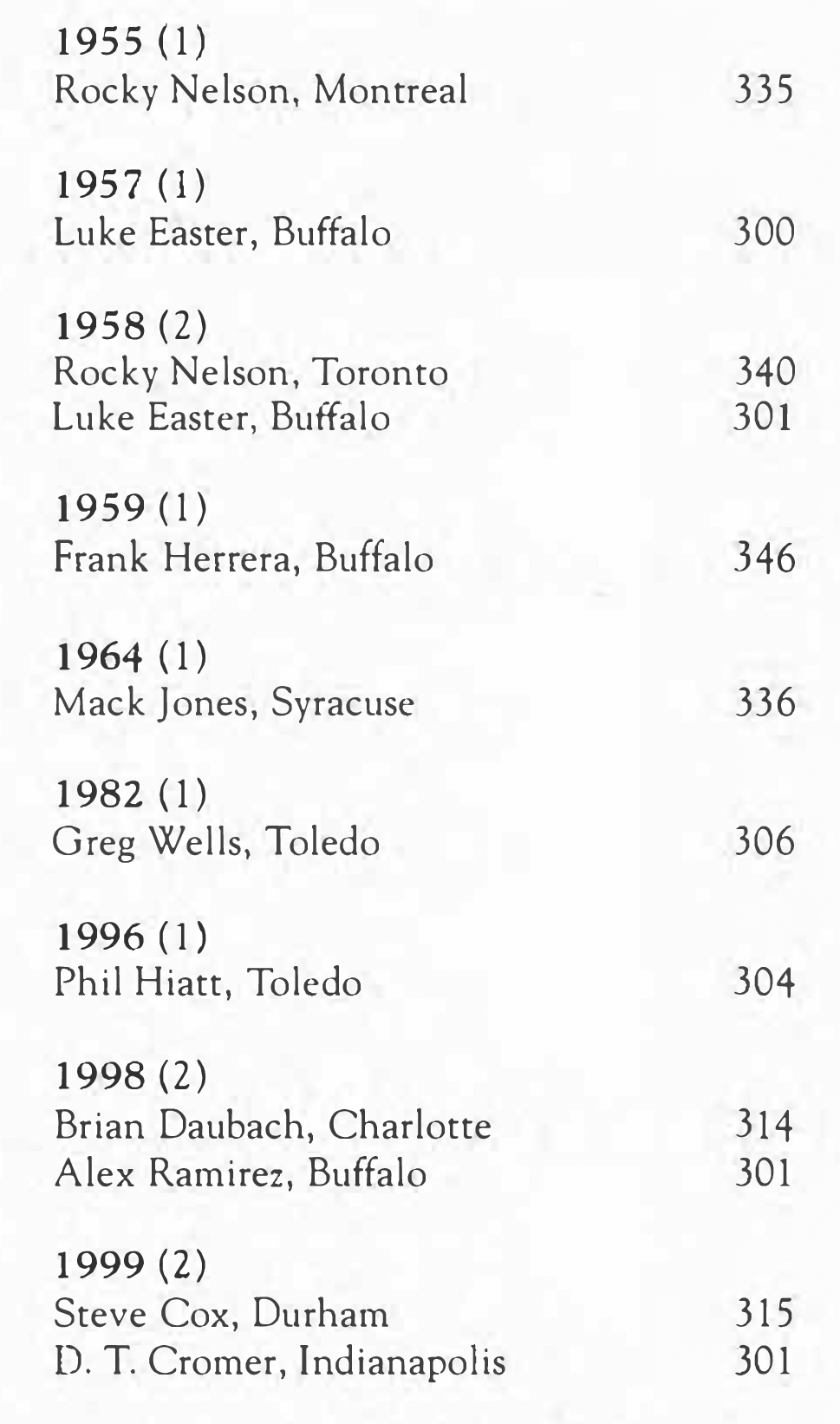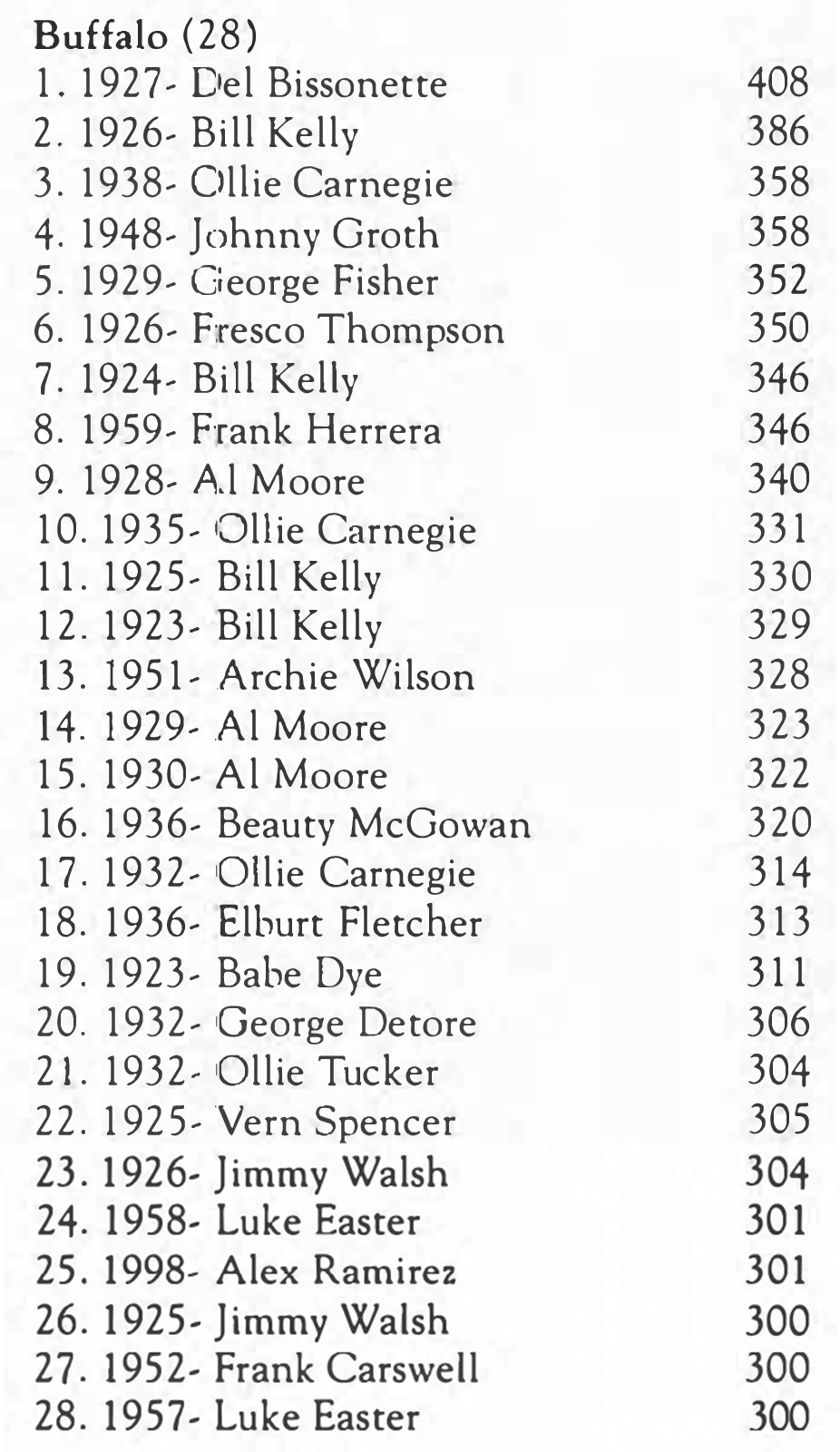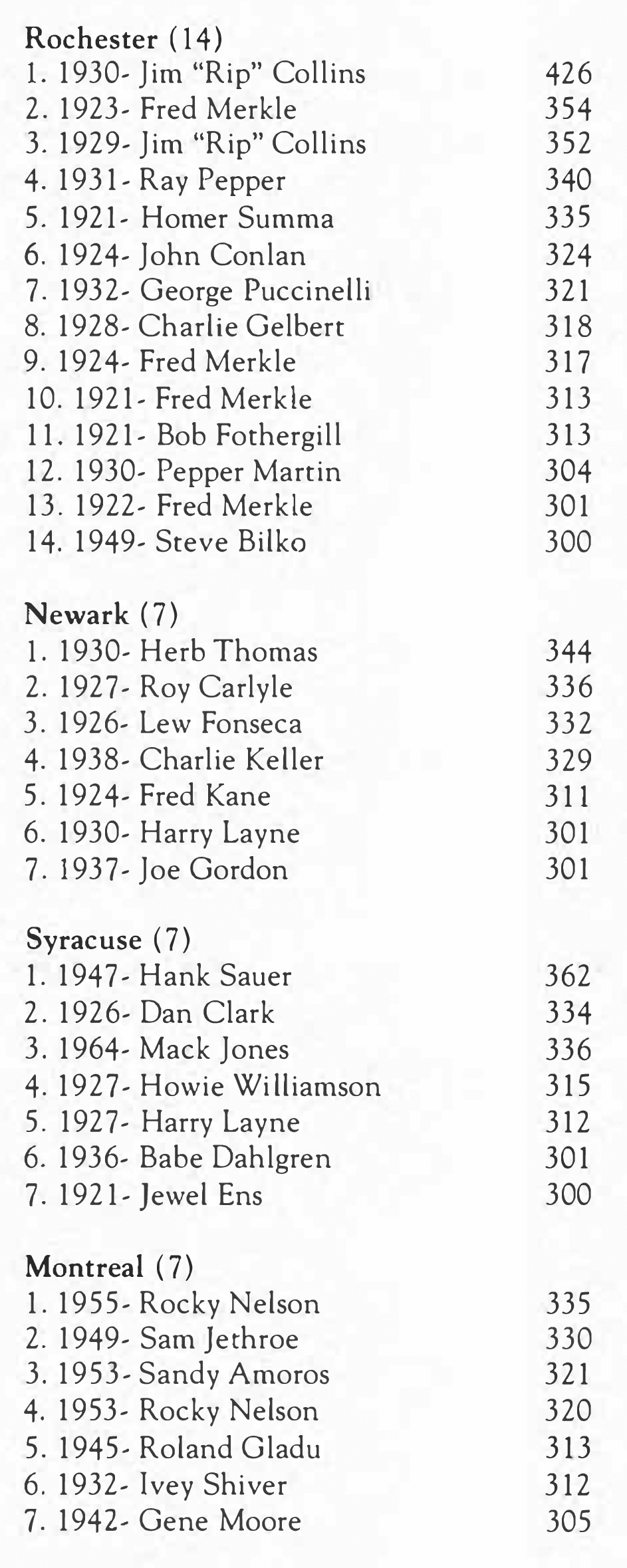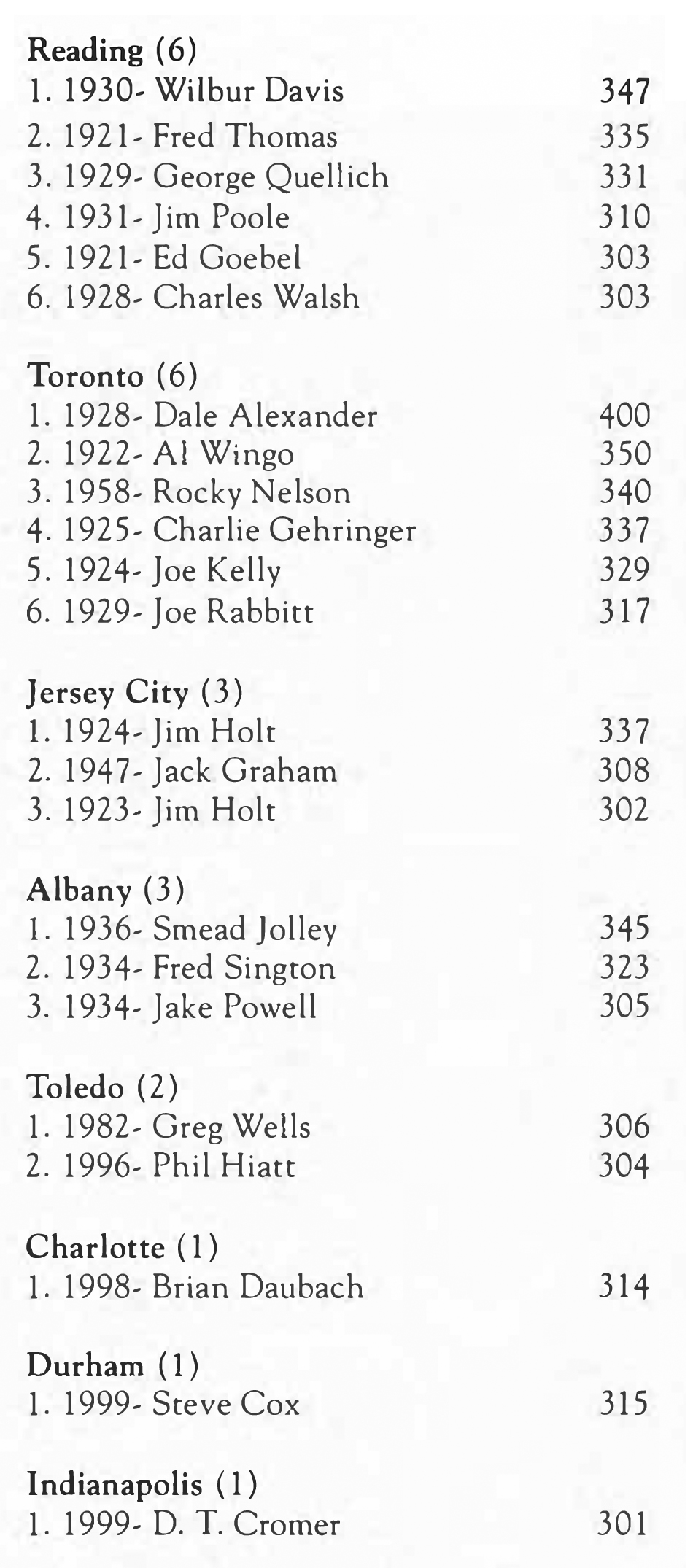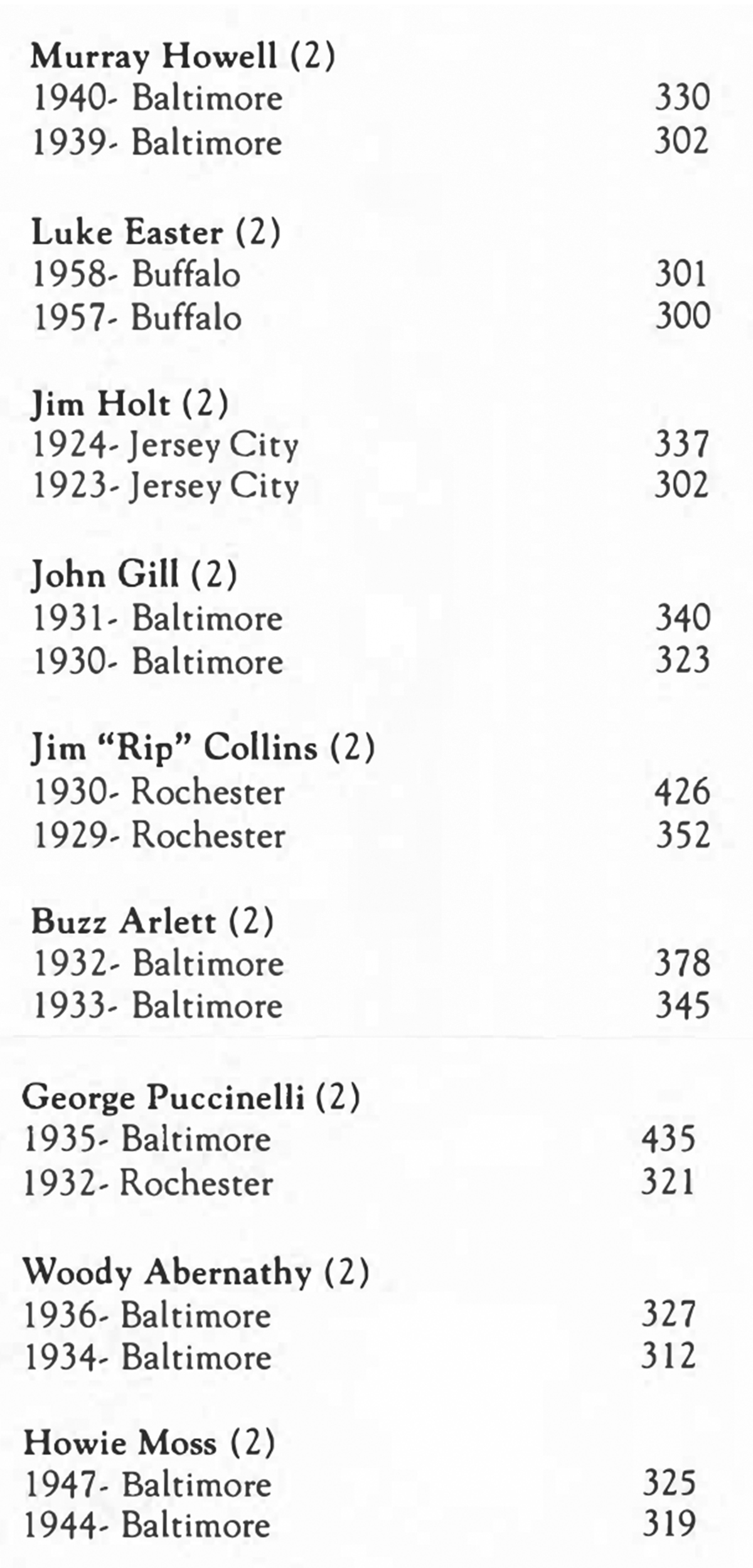International League Total Bases
This article was written by David Chrisman
This article was published in 2001 Baseball Research Journal
A good indication of what kind of offensive campaign a batter has had is to tabulate his total bases for the season. In most professional leagues, 300 total bases is excellent work. In the International League, chat level was reached 121 times from 1884 through 1999. During that same period, 400 total bases have been reached only five times.
As a club, the mighty Baltimore Orioles had the most 300 total bases achievers-39. The Buffalo Bisons had 28 such seasons, although the Buffalo franchise had a much longer stay in the circuit than did the Baltimore club. The Orioles left the circuit after the 1953 season, when the St. Louis Browns came to town and returned Baltimore to the big leagues. Buffalo played in the circuit through the 1968 campaign and re-joined the league in 1998 after a stay in the now defunct American Association.
The 300 level was reached most often in the 1920s-65 times. In the 1930s, players reached the plateau 41 times. No other decade came close. In the 1940s there were thirteen 300 coral-base seasons, and in the 1950s, only nine of them. Since 1960, the International League has seen just seven seasons when any player has totalled 300 bases. Since the 1950s (1960-1999), the circuit has had a player reach the 300 level in total bases only seven times.
The five 400-total-bases achievements in the Inter national League follow a similar pattern (twice in the ’20s and three times in the ’30s). Prior to 1920, no International League batter was successful in accumulating 300 total bases in one season. Rochester’s Wally Pipp in 1914 came the closest with 290 while other impressive marks were achieved by the following: 1898, Toronto’s Buck Freeman (284); 1896, Wilkes-Barre’s Abel Lezotte (283); 1917, Toronto’s Napoleon Lajoie (283); 1893, Buffalo’s Jake Drauby (281); and 1900, Worcester’s Kitty Bransfield (281).
Let’s look at the 300 total-base achievers from 1920 through 1999.
It is obvious that Jack Dunn’s Baltimore Orioles of the 1920s were prolific total base achievers, with the great Jack Bentley reaching 300 three times and Dick Porter four. Buffalo’s Bill Kelly and Rochester’s Fred Merkle were equally adept at amassing total bases. GM George Weiss’s Baltimore Orioles of the early thirties were as prolific at producing total bases accumulations in excess of 300 as any comparable group in league history. The high-flying Orioles of 1930 had five players in excess of 300 total bases. in 1932, the Orioles had three players reach the coveted 300 mark, as did the Buffalo Bisons.
Three Rochester Colt players reached the 300 level in total bases in 1921, and Buffalo’s Irish Mafia turned the trick in successive years (1925-26). Nobody can deny the impressive nature of Buffalo’s Del Bissonette’s offensive display in 1927-his golden season. Not only did he lead the circuit in total bases (408), but he was the league’s best in home runs (31), runs batted in (167), doubles (49) and triples (20). His 167 RBI count is the Buffalo club record and the circuit’s fourth highest ever.
In 1928, Toronto’s Dale Alexander won the triple crown with an impressive .380 average. In addition, Big Moose led the league in home runs (31 ), runs batted in (144), doubles (49), and total bases (400). It was a campaign to rival Bissonette’s 1927 season.
Baltimore’s version of Babe Ruth (Jack Bentley) just missed the coveted 400 total bases total in 1921 with 397-the league’s sixth-highest accumulation. Another Baltimore slugger, George Puccinelli ( in 1935) also won the triple crown. Along the way, the Pooch averaged .359, bashed 53 home runs and drove in 172 runs. He also led the circuit in hits (209), runs scored (135), and doubles (49). His 435 total bases achieved in that year stand as the circuit’s second highest mark. His home runs and runs batted in marks are the league’s third-highest achievements.
Buffalo’s Bill Kelly, in 1926, bashed 44 home runs and drove in 151 runs on his way to a 386 total bases attainment. In that campaign, he was joined on the 300 total bases plateau by teammates Fresco Thompson (340) and Jimmy Walsh (304). An impressive total bases accumulation can come in many forms. For example, in 1936, Albany’s Smead Jolley accumulated 345 total bases, fueled by his hits totals (221) and doubles count (52). However, more often than not, the 300 total bases mark is linked to a high home run total. Interestingly, from 1920 through 1940, at least one batter accumulated 300 total bases each season-with the high water mark of eleven players in 1930. Nobody got there in either 1941 or 1943. In the ’50s, the gaps occurred in 1950, 1954 and 1956. Only Syracuse’s Mack Jones (in 1964) reached the 300 level in the ’60s, and nary a batter accomplished the feat in the ’70s. The ’80s had only Toledo’s Greg Wells with his 1982 mark of 306.
The circuit made a comeback in the 1990s, when it expanded to include half of the defunct American Association.
Here are the International League records by team:
Rochester had all of its 300 total bases accumulations prior to 1950. Eight players associated with the New York Giants attained the mark. Seven Cardinal farmhands achieved the coveted 300 total bases attainment (between 1927 and 1960). No Baltimore Oriole farmhand in Rochester has attained the coveted 300 total base attainment. Bobby Grich, with 299 in 1971, came the closest.
As successful as Columbus has been from 1954 to the present, no Clipper or Jet player has yet achieved 300 total bases in one season.
Through 1927, Syracuse was the principal Cardinal farm in the International League and its last season with that affiliation was a great one. Harry Laynce achieved 322 total bases and Howie Williamson added 308. Dan Clark had a big year in 1926 (337 total bases). In the ’30s and ’40s, Syracuse had a Cincinnati Red working agreement. In 1936, Babe Dahlgren had 301 total bases. Hank Sauer’s monster year in 1947 set the Salt City’s all-time record at 362.
The independent Buffalo Bisons of the 1920s were a murderous hitting team. Bill Kelly accumulated 300 total bases on four separate occasions and Jimmy Walsh turned the trick twice.
In the 1930s, both Al Moore and Ollie Carnegie reached the coveted 300 total on three occasions. In the 1950s, Luke Easter had two 300 total base campaigns. Rochester’s Fred Merkle also reached the 300 mark four times, as did Baltimore’s Dick Porter.
ln 1930, the league saw Baltimore’s Joe Hauser set all-time marks in home runs ( 63) and total bases (443). Who knows the heights that Hauser might have climbed in 1931 if he hadn’t been injured. “Unser Choe” started out on a pace to eclipse his 1930 attainments. Still, his home run total (31) was good enough to lead the circuit.
Rochester’s precocious Ripper, Jim Collins, had impressive back-to-back campaigns in 1929-1930. In 1929, Collins tied Buffalo’s George Fisher in total bases (352) while leading the circuit in home runs (38) and runs batted in (134). One year later, Collins won the batting title with a high water mark of .3 76. In addition, he set the league’s all-time runs batted in mark ( 180)-five more than Hauser. Collins trailed Hauser in home runs with 40 and total bases (426). This was one of two times in the history of the circuit chat two men finished with 40 or more home runs in one season. lt was the only time that two men accumulated 400 or more total bases in a single campaign.
Montreal rose to total base prominence in the 1940s and 1950s-mainly on the broad shoulders of Rocky Nelson. In addition, Nelson in 1958 became the first Toronto Maple Leaf since 1929 to reach the 300 level in total bases.
Let’s look at the stars who had multiple 300 total base seasons in the International League:
Why have the 300 total bases accumulations begun to dry up in recent campaigns? Perhaps it is the changing nature of the game. These days an impressive farmhand seldom stays all season at the Triple A level. In an earlier era, minor league teams were more independent and often played much longer schedules than they do today. Whatever the reasons, the 300 total bases achievement has become an endangered species at the Triple A minor league level.







